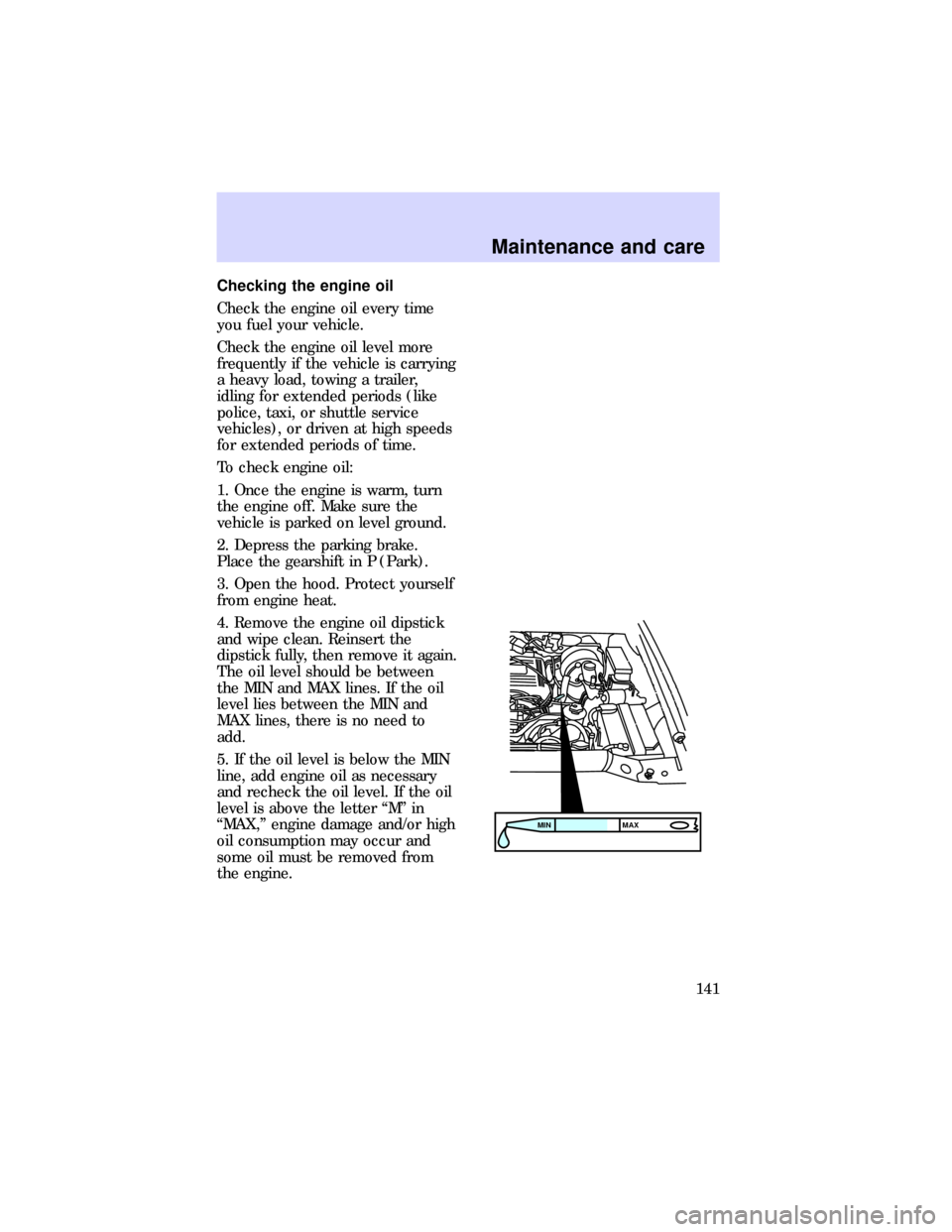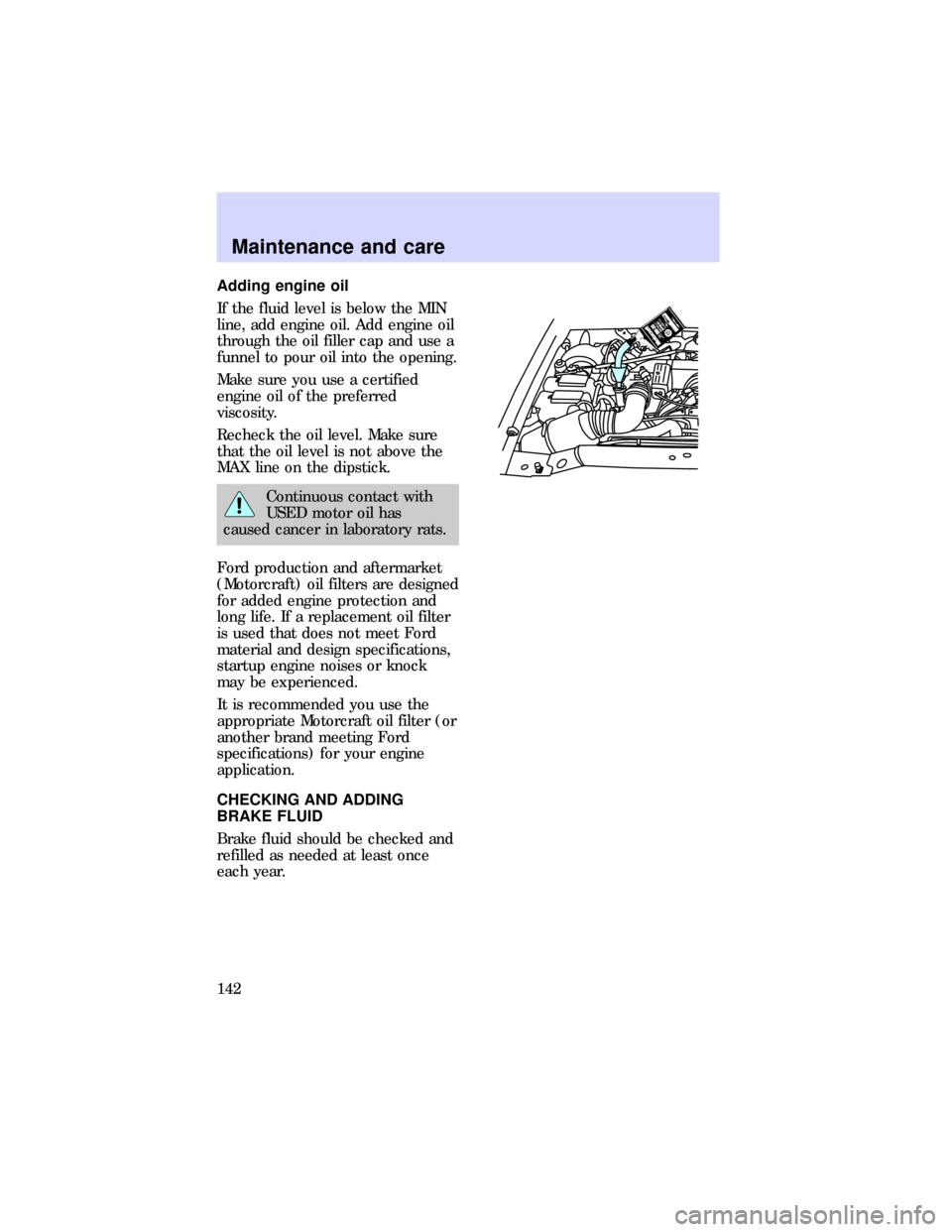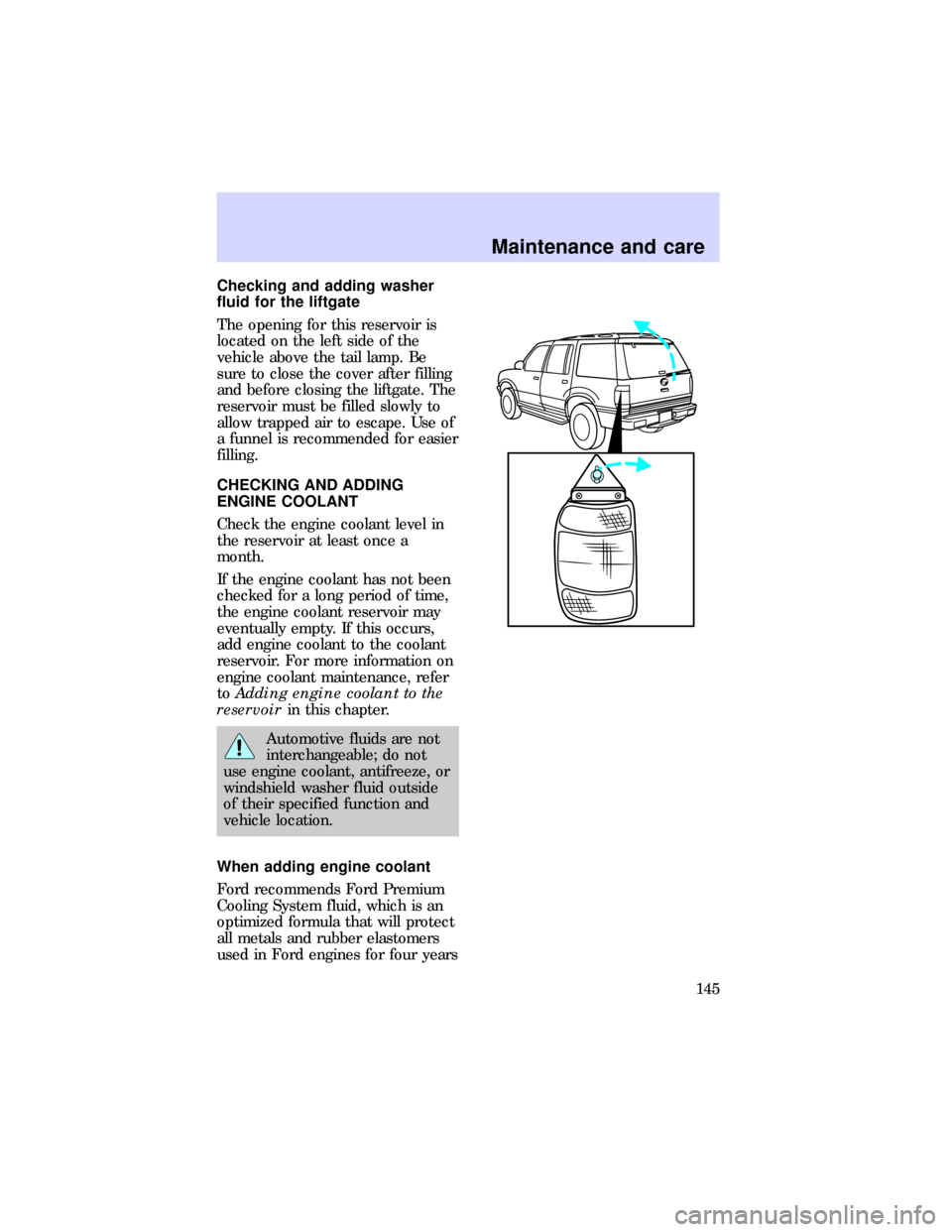check engine Mercury Mountaineer 1997 s User Guide
[x] Cancel search | Manufacturer: MERCURY, Model Year: 1997, Model line: Mountaineer, Model: Mercury Mountaineer 1997Pages: 197, PDF Size: 2.08 MB
Page 141 of 197

Checking the engine oil
Check the engine oil every time
you fuel your vehicle.
Check the engine oil level more
frequently if the vehicle is carrying
a heavy load, towing a trailer,
idling for extended periods (like
police, taxi, or shuttle service
vehicles), or driven at high speeds
for extended periods of time.
To check engine oil:
1. Once the engine is warm, turn
the engine off. Make sure the
vehicle is parked on level ground.
2. Depress the parking brake.
Place the gearshift in P (Park).
3. Open the hood. Protect yourself
from engine heat.
4. Remove the engine oil dipstick
and wipe clean. Reinsert the
dipstick fully, then remove it again.
The oil level should be between
the MIN and MAX lines. If the oil
level lies between the MIN and
MAX lines, there is no need to
add.
5. If the oil level is below the MIN
line, add engine oil as necessary
and recheck the oil level. If the oil
level is above the letter ``M'' in
``MAX,'' engine damage and/or high
oil consumption may occur and
some oil must be removed from
the engine.
MAX MIN
Maintenance and care
141
Page 142 of 197

Adding engine oil
If the fluid level is below the MIN
line, add engine oil. Add engine oil
through the oil filler cap and use a
funnel to pour oil into the opening.
Make sure you use a certified
engine oil of the preferred
viscosity.
Recheck the oil level. Make sure
that the oil level is not above the
MAX line on the dipstick.
Continuous contact with
USED motor oil has
caused cancer in laboratory rats.
Ford production and aftermarket
(Motorcraft) oil filters are designed
for added engine protection and
long life. If a replacement oil filter
is used that does not meet Ford
material and design specifications,
startup engine noises or knock
may be experienced.
It is recommended you use the
appropriate Motorcraft oil filter (or
another brand meeting Ford
specifications) for your engine
application.
CHECKING AND ADDING
BRAKE FLUID
Brake fluid should be checked and
refilled as needed at least once
each year.
Maintenance and care
142
Page 145 of 197

Checking and adding washer
fluid for the liftgate
The opening for this reservoir is
located on the left side of the
vehicle above the tail lamp. Be
sure to close the cover after filling
and before closing the liftgate. The
reservoir must be filled slowly to
allow trapped air to escape. Use of
a funnel is recommended for easier
filling.
CHECKING AND ADDING
ENGINE COOLANT
Check the engine coolant level in
the reservoir at least once a
month.
If the engine coolant has not been
checked for a long period of time,
the engine coolant reservoir may
eventually empty. If this occurs,
add engine coolant to the coolant
reservoir. For more information on
engine coolant maintenance, refer
toAdding engine coolant to the
reservoirin this chapter.
Automotive fluids are not
interchangeable; do not
use engine coolant, antifreeze, or
windshield washer fluid outside
of their specified function and
vehicle location.
When adding engine coolant
Ford recommends Ford Premium
Cooling System fluid, which is an
optimized formula that will protect
all metals and rubber elastomers
used in Ford engines for four years
Maintenance and care
145
Page 148 of 197

Checking the cooling system
hoses
Before adding or replacing coolant,
inspect all cooling system hoses
for:
²deterioration
²leaks
²loose clamps
CHECKING AND ADDING
POWER STEERING FLUID
Check the power steering fluid at
least twice a year by completing
the following steps:
1. Start the engine.
2. When the engine coolant
temperature gauge reaches the
normal zone, turn off the engine.
CH
Maintenance and care
148
Page 150 of 197

Your vehicle does not use up
transmission fluid. However, it is
recommended that you check the
transmission fluid at least twice a
year. The fluid level should be
checked if the transmission is not
working properly, i.e., the
transmission slips or shifts slowly
or if you notice some sign of fluid
leakage.
It is preferable to check the
transmission fluid level at normal
operating temperature, after
approximately 32 km (20 miles) of
driving. However, if necessary, you
can check the fluid level without
driving to obtain a normal
operating temperature if the
outside temperature is above 10ÉC
(50ÉF).
If the vehicle has been operated
for an extended period at high
speeds, in city traffic during hot
weather or pulling a trailer, the
vehicle should be turned off for
about 30 minutes to allow the fluid
to cool before checking.
1. Park the vehicle on a level
surface.
2. Start the engine and move the
gearshift lever through all of the
gear ranges. Allow sufficient time
for each gear to change.
3. Latch the gearshift lever in
P(Park), set the parking brake and
leave the engine running.
4. Remove the dipstick, wiping it
clean with a clean, dry rag.
5. Install the dipstick.
P R N D 2 1
Maintenance and care
150
Page 154 of 197

the electrolyte level and adding
water. Check the electrolyte level
every 24 months or 40,000 km
(24,000 miles) in average
temperatures 32ÉC (90ÉF). Keep
the electrolyte level in each cell up
to the level indicator. Do not
overfill.
If the level gets low, refill the
battery with distilled water. If
necessary, distilled water may be
substituted with tap water that is
not hard and does not have a high
mineral or alkali content. If the
battery needs water quite often,
have the charging system checked
for a possible malfunction.
Your vehicle is equipped with a
battery saver control feature
designed to prevent your battery
from accidental wear down due to
doors left ajar. For information on
the system and how it works, see
Interior overhead lampin the
Controls and featureschapter.
Because your vehicle's engine is
electronically controlled by a
computer, some control conditions
are maintained by power from the
battery. When the battery is
disconnected or a new battery is
installed, the computer must
ªrelearnº its idle conditions before
your vehicle will drive properly. To
begin this process:
1. Put the gearshift in P (Park).
2. Turn off all accessories, and
start the vehicle.
Maintenance and care
154
Page 156 of 197

Changing your air filter
1. Loosen the clamp that secures
the air cleaner in place. Separate
the two halves of the air cleaner.
2. Remove the air filter element
from the open end of the engine
air cleaner and replace it with a
new element.
3. Replace the two halves of the
air cleaner and secure the clamp.
CHECKING AND CHANGING
WIPER BLADES
Check the windshield wiper blades
at least twice a year or whenever
the wipers seem less effective than
usual. Substances such as tree sap
and some hot wax treatments used
by commercial car washes can
reduce the effectiveness of wiper
blades.
Maintenance and care
156
Page 170 of 197

If you notice one or more of the
following, the emission system may
not be working properly. Have the
vehicle serviced as soon as
possible.
²Fluid leaks.
²The
andCHECK
ENGINElights
illuminate in the instrument
cluster and remain lit.
²Strange odors.
²Engine runs more than five
seconds after shut-off or engine
misfires, surges, stalls or
backfires.
²Loss of oil pressure.
When servicing your vehicle, never
use a metal exhaust collector. A
metal collector may heat or deform
plastic parts.
Important emission control
information
By law, anyone who manufactures,
repairs, services, sells, leases,
trades vehicles, or supervises a
fleet of vehicles is not permitted to
intentionally remove an emission
control device or prevent it from
working.
Do not make any unauthorized
changes to the vehicle or engine.
Changes that cause more
unburned fuel to reach the exhaust
system can increase the
temperature of the engine or
exhaust system.
Maintenance and care
170
Page 171 of 197

Preparing your vehicle for
inspection/maintenance testing
In some localities it may become a
legal requirement to pass an
Inspection/Maintenance test of the
On-Board Diagnostic (OBD II)
system. If the vehicle's powertrain
system or battery has just been
serviced, the OBD II system is
reset to a not ready for I/M testing
condition. To ready the OBD II
system for I/M testing, the law
specifies that additional mixed city
and highway driving is necessary
to complete the check of the OBD
II system.
The driving modes required to
reach the ready condition consist
of a minimum of 30 minutes of city
and highway driving as described
below:
²20 minutes of driving in stop
and go city-type traffic with at
least four idle periods.
²10 minutes of driving on an
expressway or highway.
Before completing the above
driving modes, the engine must be
warmed up and at operating
temperature. Once started, the
vehicle must not be turned off
during the above driving modes. If
the vehicle owner is unable to
meet the I/M requirements by
using these driving patterns, an
authorized service center can
perform a detailed OBD II Drive
Cycle as it would any other type of
repair work.
Maintenance and care
171
Page 193 of 197

Air bag supplemental restraint
system ............71,74,75,76,77,82,87
and child safety
seats .......................74,76,77,82,87
description ................................73
indicator light ...........................74
Air cleaner filter
replacing ..................................156
All Wheel Drive .........................102
Anti-theft system ........................56
arming the system ....................56
disarming a triggered system ..57
disarming an untriggered
system .......................................57
Audio system (see Electronic
sound system) .............................16
Autolamp system (see
Headlamps) .................................33
Automatic transmission ..............98
fluid, adding ............................149
Battery .......................................153
battery saver .............................58
how to service ........................153
Brake fluid
checking and adding ..............142
Brakelamp
bulb replacement ....................174
Brakes ..........................................97
adjustment ................................96
anti-lock .....................................96
anti-lock brake system (ABS)
warning light .............................97
parking ......................................97
Break-in period .............................3
Bulbs, replacing
specifications ..........................179
Cargo area shade ...................46,47
Cargo cover ............................46,47
Childproof locks ..........................39
Chime ...........................................11
headlamps on ............................12
key-in-ignition ...........................11safety belt ............................11,69
Cleaning your vehicle
built-in child seat ...................184
engine compartment ..............183
exterior ....................................182
instrument panel ....................182
plastic parts ............................182
safety belts ..............................184
washing ....................................181
wheels ......................................182
wiper blades ............................183
Climate control
system ...........................17,18,19,21
air conditioning .........................21
heating .......................................21
Compass, electronic
calibration .................................30
set zone adjustment .................30
Compass/temperature display ...29
Console, description ...................42
Controls
instrument panel ......................13
steering column ........................22
Daytime running light system ...14
Defects, reporting .....................192
Defrost
rear window ..............................15
Driving under special
conditions
towing a trailer .......................114
Electronic sound system ............16
Emission control system ..........168
Engine .................................139,189
Engine block heater ...................93
Engine coolant
checking and adding ..............145
checking hoses .......................148
Engine coolant temperature
gauge ..............................................7
Engine oil
checking and adding .......140,142
Exhaust fumes ............................94
Index
193